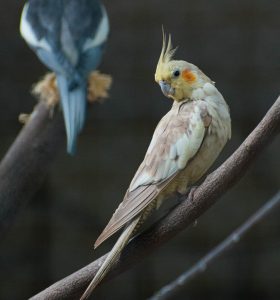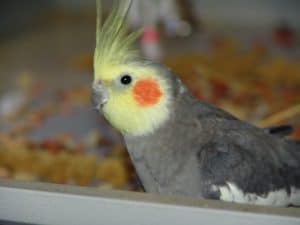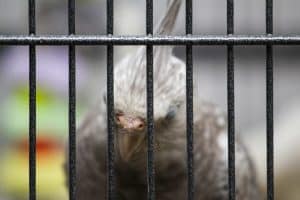Have you ever wondered, “Do cockatiels dance?” You’re not alone in this curiosity! Cockatiels, like many pet birds, have a unique relationship with music. In fact, it’s not uncommon for these feathered friends to show off their moves and sway to the rhythm of their favorite songs. While not all cockatiels may exhibit this behavior, it’s a delightful sight when they do.
Music has a significant impact on cockatiels and can even help you build a closer bond with your feathered friend. Different types of music may cater to different birds’ preferences, and you might find your little guy tapping his feet to light pop, classical music, or any other genre that strikes his fancy. So, crank up the tunes and watch as your cockatiel starts dancing to the beats!
Understanding Cockatiel Behavior

If you’re wondering, do cockatiels dance? The simple answer is yes, cockatiels do dance. These delightful pet birds are known for their love of music, and they’re often seen moving and grooving to their favorite tunes.
Cockatiels, like most birds, enjoy various types of music. While they may not be tapping their feet to the same rhythm as humans, their dancing is a charming and fascinating natural behavior. Some cockatiels might prefer classical music, while others might enjoy light pop or even the sound of your singing. It’s essential to observe your feathered friend’s reactions to different music types and find which specific music they enjoy the most.
Dancing is not the only form of communication for cockatiels. They can also use their vocalizations, body language, and other physical cues to signal their needs, emotions, and desires. While dancing, they may express their happiness, attentiveness, or even a desire to bond with their owner. It’s vital to understand these various behaviors to ensure your cockatiel’s well-being and happiness.
Playing music for your cockatiel can also have several additional benefits. For one, it can help alleviate boredom when they are in their cage, as well as provide mental stimulation. Be cautious, however, with loud music or playing music constantly, as it may create stress for your feathery friend.
So, how can you tell if your cockatiel enjoys the music you’re playing? Pay attention to their body language and movements:
- Bird Moves: Do they start dancing or bobbing their head when you play certain songs? That’s a great sign that your cockatiel likes the tune.
- Feather Posture: If their feathers are puffed up and they seem relaxed, that means they’re most likely enjoying the music.
- Vocalization: Do they respond to the music with their unique chirps, whistles, or even singing along? That could indicate they’re happy with the song choice.
It’s not only cockatiels that appreciate good music. Other birds and even animals such as cats and dogs have also shown a preference for specific tunes and sounds. By exposing your pets to various music types and observing their reactions, you’ll not only strengthen your connection with them but also gain valuable insights into their preferences and personalities.
Body Language and Dance Movements

Cockatiels dance to express themselves, show off for potential mates, and strengthen their bond with you. So, the next time you play music for your feathered friend, be sure to watch out for these adorable body language signs and dance moves.
Cockatiels, as well as other birds, have a natural affinity for rhythm. When playing music for your pet, you may notice cockatiels dancing to the beat. It’s essential, however, to select the right type of music. Most cockatiels prefer light pop or classical music, as loud or aggressive tunes may cause stress. By choosing your cockatiel’s favorite music, you’ll encourage them to let loose and start dancing.
Moreover, music affects cockatiels in different ways:
- Stimulates their vocal abilities, encouraging them to sing and mimic tunes
- Enhances their mood, making them feel happy and content
- Increases bonding between you and your pet
While most birds dance for the same reasons, it’s crucial to monitor your cockatiel’s reaction to specific songs. If you notice your little guy tapping their feet, bobbing their head, or swaying side to side, it’s a sign they’re enjoying the music.
The following table outlines some common dance moves you might observe while your cockatiel listens to music:
| Dance Move | Description |
| Foot tapping | Tapping one or both feet to the rhythm |
| Head bobbing | Nodding their head in time with the music |
| Swaying | Rocking from side to side |
But always remember – each cockatiel is unique, and their dancing preferences may vary. It’s essential to pay close attention to your bird’s response to different tunes to understand which ones they enjoy the most.
- STURDY CONSTRUCTION - Made of a premium low-carbon steel frame with a black coating that makes this bird cage sturdy, durable, even against playful birds; Guaranteed to resist wear and rust
- PORTABLE AND LIGHTWEIGHT - This bird cage is just 14 lbs., which is lightweight and easy for you to carry for short-term traveling; The compact design allows you to store it with less used space; Product Dimensions: 18.9" (L) 15" (W) 18.7" - 25.6" (H)
- HIGH SAFETY - The spacing between the longitudinal bars at the bottom of the cage is 0.6", so birds can safely jump and play without injury; Ensure the safety of your lovely friends
- 2 IN 1 DESIGN - Equipped with a wooden perch on the top of this bird cage, your birds can stay there and play with each other; And you can lift this bird cage with the wooden perch
- EASY TO ASSEMBLE - The integrated design allows you to easily assemble it within 30 minutes with just a few small tools; It also comes with a colorful rope for the entertainment of birds
Causes of Dancing in Cockatiels
There are several factors that can lead to cockatiels dancing, and we’ll explore them below.
One major reason cockatiels dance is a reaction to the music they hear. When you play music for your cockatiel, it’s common to find them swaying or bobbing their head to the rhythm. Even though loud music might be too much for your feathered friend, they generally enjoy listening to a wide variety of tunes. In fact, many pet birds have been observed dancing to different genres of music, from classical music to light pop.
Just like humans, cockatiels enjoy music and may have specific preferences. It’s not uncommon for a cockatiel to show a liking for one song and ignore another. As with most birds, finding your cockatiel’s favorite music can be a trial-and-error process. Observing how your cockatiel dances in response to specific songs can help you learn what makes their little heart soar.
Dancing isn’t exclusive to cockatiels, as many other birds have been observed displaying similar behavior. The phenomenon of birds dancing has been documented in various species, indicating that an appreciation for music exists across the avian world.
Dancing can also be a way for your cockatiel to communicate with you and create a closer bond. While listening to playing music, a cockatiel might respond with vocalizations, wing flapping, or synchronized body movements. This combination of singing and dancing allows your feathered friend to engage with you on a deeper level.
Lastly, dancing is often a sign of well-being in cockatiels. When a cockatiel likes a tune and starts to dance, it’s usually an indication that they’re feeling happy and content in their environment. Make sure your cockatiel has a comfortable and safe space within their cage to encourage their dancing behavior.
Encouraging Dance in Your Cockatiel

Like most birds, cockatiels dance to express themselves, have fun, and release energy. So how can you encourage your pet cockatiel to start dancing? Let us explore some useful tips.
Firstly, play music for your bird to engage with. Cockatiels enjoy music, and playing tunes can stimulate them to dance. It’s crucial to select the right type of music that your cockatiel likes. Generally, cockatiels prefer gentle melodies like classical music or light pop songs. Avoid playing loud music, as it could overwhelm or even frighten your pet bird. Observe your cockatiel’s reaction to different types of tunes to identify their favorite music.
Creating a safe and comfortable environment for your cockatiel is essential. Make sure their cage is spacious, clean, and allows them to move freely while they dance. Your bird should feel secure and relaxed in its surroundings.
Engage with your cockatiel often. You can whistle, sing tunes, or imitate your bird’s sounds and establish a closer bond. The more you interact, the more likely they are to feel comfortable dancing in front of you.
Additionally, you can expose your cockatiel to videos of other birds dancing to inspire movement. This can be helpful, as cockatiels and other birds learn and mimic behaviors from each other.
Encouraging dancing in your pet bird, like most pet birds, offers various benefits. When cockatiels dance, it’s a sign they’re feeling happy, content, and comfortable in their environment. Dancing also helps strengthen their leg muscles and maintain overall health.
Give them the freedom to dance when they feel inclined. Observe and appreciate their unique rhythm and style. Reward their behavior with treats and positive reinforcement, which associates dancing with good feelings.
Here’s a quick list of helpful tips for encouraging your cockatiel to dance:
- Play gentle music, like classical or light pop.
- Create a comfortable and spacious environment.
- Engage and interact with your bird.
- Show your cockatiel videos of other birds dancing.
- Look for specific music that your cockatiel likes.
- Reward with treats and positive reinforcement.
By implementing these steps, you’ll be on your way to helping your cockatiel unleash their charming dance moves. So sit back, enjoy the show, and relish the fun-loving personality of your feathered friend.
Final Thoughts
Cockatiels, like many pet birds, can dance to music, indicating their love for tunes and rhythms. Music has a significant impact on cockatiels and can help build a closer bond with the bird. Observing a cockatiel’s reactions to different music types, such as light pop or classical, helps owners understand their preferences.
Dancing is just one form of communication used by these birds, with vocalizations, body language, and other physical cues expressing their needs and emotions. Playing music can provide mental stimulation and alleviate boredom for a cockatiel, but it is important not to create stress by playing music too loudly or constantly. Observing a cockatiel’s body language and movements, such as foot tapping, head bobbing, or swaying, can help determine if they enjoy certain music. To encourage dancing, create a safe environment, engage with the bird, expose it to videos of other birds dancing, and reward with treats and positive reinforcement.
Other suggested articles:




